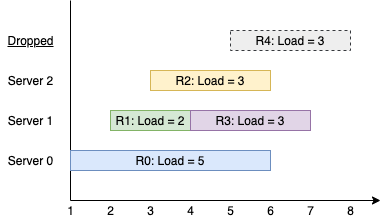1606. Find Servers That Handled Most Number of Requests
Description
You have k servers numbered from 0 to k-1 that are being used to handle multiple requests simultaneously. Each server has infinite computational capacity but cannot handle more than one request at a time. The requests are assigned to servers according to a specific algorithm:
- The
ith(0-indexed) request arrives. - If all servers are busy, the request is dropped (not handled at all).
- If the
(i % k)thserver is available, assign the request to that server. - Otherwise, assign the request to the next available server (wrapping around the list of servers and starting from 0 if necessary). For example, if the
ithserver is busy, try to assign the request to the(i+1)thserver, then the(i+2)thserver, and so on.
You are given a strictly increasing array arrival of positive integers, where arrival[i] represents the arrival time of the ith request, and another array load, where load[i] represents the load of the ith request (the time it takes to complete). Your goal is to find the busiest server(s). A server is considered busiest if it handled the most number of requests successfully among all the servers.
Return a list containing the IDs (0-indexed) of the busiest server(s). You may return the IDs in any order.
Example 1:

Input: k = 3, arrival = [1,2,3,4,5], load = [5,2,3,3,3] Output: [1] Explanation: All of the servers start out available. The first 3 requests are handled by the first 3 servers in order. Request 3 comes in. Server 0 is busy, so it's assigned to the next available server, which is 1. Request 4 comes in. It cannot be handled since all servers are busy, so it is dropped. Servers 0 and 2 handled one request each, while server 1 handled two requests. Hence server 1 is the busiest server.
Example 2:
Input: k = 3, arrival = [1,2,3,4], load = [1,2,1,2] Output: [0] Explanation: The first 3 requests are handled by first 3 servers. Request 3 comes in. It is handled by server 0 since the server is available. Server 0 handled two requests, while servers 1 and 2 handled one request each. Hence server 0 is the busiest server.
Example 3:
Input: k = 3, arrival = [1,2,3], load = [10,12,11] Output: [0,1,2] Explanation: Each server handles a single request, so they are all considered the busiest.
Constraints:
1 <= k <= 1051 <= arrival.length, load.length <= 105arrival.length == load.length1 <= arrival[i], load[i] <= 109arrivalis strictly increasing.
Solutions
Solution: Priority Queue
- Time complexity: O(nlogk)
- Space complexity: O(n+k)
JavaScript
/**
* @param {number} k
* @param {number[]} arrival
* @param {number[]} load
* @return {number[]}
*/
const busiestServers = function (k, arrival, load) {
const n = arrival.length;
const servers = Array.from({ length: k }, () => 0);
const busyServers = new MinPriorityQueue(({ server, idleTime }) => idleTime || server);
let beforeModIdleServers = new MinPriorityQueue();
let afterModIdleServers = new MinPriorityQueue();
for (let server = 0; server < k; server++) {
beforeModIdleServers.enqueue(server);
}
for (let index = 0; index < n; index++) {
const time = arrival[index];
const idleTime = time + load[index];
const modServer = index % k;
if (!modServer) {
afterModIdleServers = beforeModIdleServers;
beforeModIdleServers = new MinPriorityQueue();
}
while (busyServers.size() && busyServers.front().idleTime <= time) {
const { server } = busyServers.dequeue();
server < modServer ? beforeModIdleServers.enqueue(server) : afterModIdleServers.enqueue(server);
}
while (afterModIdleServers.size() && afterModIdleServers.front() < modServer) {
const server = afterModIdleServers.dequeue();
beforeModIdleServers.enqueue(server);
}
const server = afterModIdleServers.dequeue() ?? beforeModIdleServers.dequeue();
if (server === null) continue;
servers[server] += 1;
busyServers.enqueue({ server, idleTime });
}
const maxRequest = Math.max(...servers);
const result = [];
for (let server = 0; server < k; server++) {
if (servers[server] < maxRequest) continue;
result.push(server);
}
return result;
};